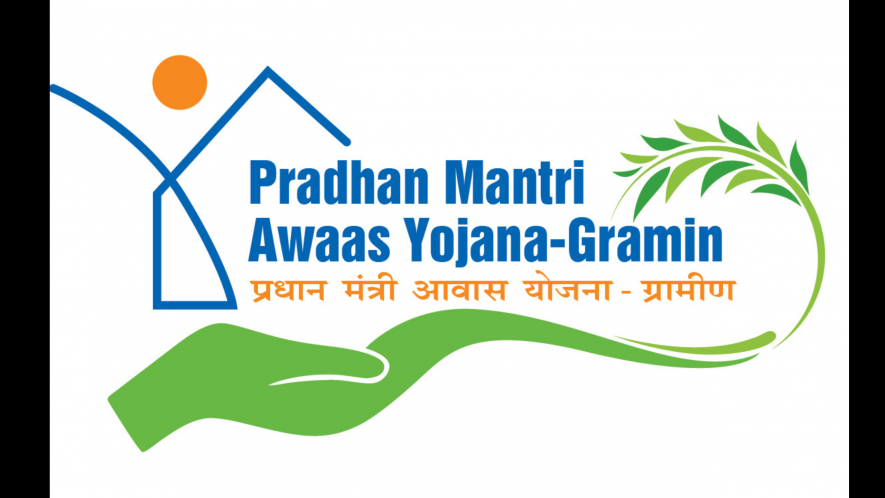Corruption Deep-Rooted in West Bengal PMAY-G

Logo of PMAY-G. Image Courtesy: MyGov
Housing is the basic necessity of people living around the poverty line with a daily spending ability of Rs 32 or less. India has a population of around 25 crore for whom ‘Roti Kapda aur Makaan’ is the primary need for survival.
The government’s Pradhan Mantri Awaas Yojana (PMAY) is a flagship project for building houses for the poor. About 2.95 crore houses are to be built in rural areas by 2024 with the Centre and the state governments sharing the expenses in the 60:40 ratio.
The list of primary beneficiaries was prepared by gram panchayats based on socioeconomic survey data. Since Panchayats are considered local governments run by the stakeholders of the rural community, beneficiary selection and funding by the state and Central governments makes the scheme inclusive.
However, the success of implementing the scheme depends on the transparency and accountability of three different government establishments.
In West Bengal, 11.37 lakh houses are to be built within the next three months using Central assistance of Rs 8,200 crore failing which penalty will be imposed on the state or the funds may be reallocated to other states who performed well in time.
The names of 30%-40% of actual beneficiaries were excluded in Jhargram, East Midnapur north Dinajpur and Malda districts. In East Burdwan, Purulia and Murshidabad, the excluded number ranges between 10% and 15%.
Moreover, thousands of ineligible names were found in the primary list of beneficiaries who don’t fulfil the selection criteria. The alleged corruption has become a major socio-political issue in West Bengal, where Panchayat elections are due in April–May.
In the last Panchayat elections in 2018, there was a record highest number of 34% uncontested seats with the ruling Trinamool Congress (TMC) floating the slogan of “Opposition-free” Panchayat and allegedly manipulating the police, administration and the State Election Commission.
The polls were considered one of the bloodiest and most violent elections in recent Indian political history. The TMC won 95% of Zilla Parishad seats, nearly 83% of Panchayat Samitis and about 70% of Gram Panchayats. Therefore, the controversial list of PMAY-G beneficiaries recommended by the Panchayats needs to be analysed.
It is true that corruption has been institutionalised in different spheres of governance in the last 10 years of the TMC regime. Financial scams like Saradha, Rose Valley and Narada were unearthed by the media. But the hue and cry triggered by such scams were not reflected in the election results with TMC emerging victorious.
The correlation between corruption and electoral support has not been found to vary linearly. Rather, the politics of creating large beneficiary groups has helped the TMC to retain its electoral support despite the multi-level corruption.
The large group of beneficiaries created by the government with a lot of unplanned expenditures became an integral part of the ruling establishment. Besides, the democratic functioning of Panchayats has been totally jeopardised in the so-called “ Opposition-free” rural bodies.
The borderline between the ruling party and the government had disappeared by this time. As a result of such unipolar undemocratic governance, Panchayats lost their general accountability to the people. TMC leaders in Panchayats started to exercise their ‘supreme’ political power to identify the beneficiaries based on political obedience and not need-based parameters.
In fact, Bengal’s Panchayat system, considered the first successful model of local governance in the country under the erstwhile Left Front rule, has now transformed into a feudal model of governance. The practices of the feudal ‘zamindari’ system have been introduced in village politics.
The spirit of participation of local stakeholders, democratisation of institutional practices and the code of accountability in Panchayats were the landmarks of the success of rural development in Bengal. The participatory governance system, modelled to check corruption during the Left rule, has now turned into a model of institutional corruption.
The ecosystem of TMC members in Panchayat is significantly dependent on the earnings from ‘cut money’ received from government-sponsored schemes starting from Lokkhir Vandar to Sobuj Sathi.
The extent of such cut money was so rampant that TMC boss and chief minister Mamata Banerjee had to introduce the Didike Bolo programme in 2019 wherein people could call the CM Office to lodge complaints against TMC leaders who took cut money from people for disbursement of benefits under government schemes.
However, the initiative was purely an eyewash and a poll strategy to tone down the growing anger against corruption. Recently, the party launched an app called Didir Doot to assess the effectiveness of government programmes in rural areas. The poll strategy was to reach every family by arranging night stays for higher-level leaders to enquire about the number of benefits received by common people.
It is evident that even after the TMC’s huge electoral success in the 2021 Assembly election, the level of benefits supposed to get trickle down was inappropriate. The major reason may be due to police inaction against corrupt leaders in districts who are the kingmakers in Panchayats.
Several TMC members who had three-storeyed air-conditioned houses and SUV cars received relief funds for the repair work following the Amphan super cyclone. The funds were siphoned off by such party members using government machinery, including local BDOs and SDOs, but no action was taken.
Inaction emboldened corrupt leaders to earn the largest share of cut money using the Bangla Awaas Yojna, which includes the highest budgetary provision among other operational schemes at the Panchayat level.
But this time, the anger of people against the Awaas Yojana scam is distinctly visible in different districts. The social pressure in some areas compelled TMC Panchayat leaders to step down. TMC leaders have started blaming BJP members who had left the TMC a few years ago due to corruption charges in the Awaas Yojana.
Now, TMC leaders have suddenly started talking about a zero-tolerance policy towards corruption due to the rising unrest in rural areas with some of them blaming BDOs. The blame game proves that the corruption in the scheme is deep-rooted and similar to the teacher recruitment scam in Bengal. TMC leaders and the administration have played a major role in both scams.
As mentioned above, housing is the primary need of the poor. The Panchayat elections will show how the people of West Bengal react to the corruption in Awaas Yojana.
The writer is a professor at the Department of Construction Engineering, Jadavpur University, Kolkata.
Get the latest reports & analysis with people's perspective on Protests, movements & deep analytical videos, discussions of the current affairs in your Telegram app. Subscribe to NewsClick's Telegram channel & get Real-Time updates on stories, as they get published on our website.
























